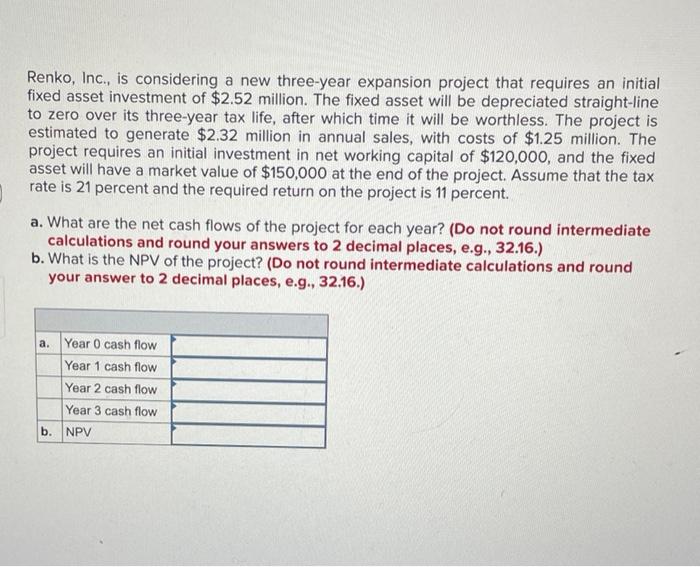Consider an asset that costs $565,000 and is depreciated straight-line to zero over its eight-year tax life. The asset is to be used in a five-year project; at the end of the project, the asset can be sold for $110,000. If the relevant tax rate is 21 percent, what is the aftertax cash flow from the sale of this asset? (Do not round intermediate calculations and round your answer to 2 decimal places, e.g., 32.16.) Renko, Inc., is considering a new three-year expansion project that requires an initial fixed asset investment of $2.52 million. The fixed asset will be depreciated straight-line to zero over its three-year tax life, after which time it will be worthless. The project is estimated to generate $2.32 million in annual sales, with costs of $1.25 million. Assume the tax rate is 21 percent and the required return on the project is 11 percent. What is the project's NPV? (A negative answer should be indicated by a minus sign. Do not round intermediate calculations and round your answer to 2 decimal places, e.g., 32.16.) Renko, Inc., is considering a new three-year expansion project that requires an initial fixed asset investment of $2.52 million. The fixed asset will be depreciated straight-line to zero over its three-year tax life, after which time it will be worthless. The project is estimated to generate $2.32 million in annual sales, with costs of $1.25 million. The project requires an initial investment in net working capital of $120,000, and the fixed asset will have a market value of $150,000 at the end of the project. Assume that the tax rate is 21 percent and the required return on the project is 11 percent. a. What are the net cash flows of the project for each year? (Do not round intermediate calculations and round your answers to 2 decimal places, e.g., 32.16.) b. What is the NPV of the project? (Do not round intermediate calculations and round your answer to 2 decimal places, e.g., 32.16.) Renko, Inc., is considering a new three-year expansion project that requires an initial fixed asset investment of $2.52 million. The fixed asset falls into the three-year MACRS class (MACRS Table). The project is estimated to generate $2.32 million in annual sales, with costs of $1.25 million. The project requires an initial investment in net working capital of $120,000, and the fixed asset will have a market value of $150,000 at the end of the project. Assume that the tax rate is 21 percent and the required return on the project is 11 percent. a. What is the net cash flow of the project for each year? (A negative answer should be indicated by a minus sign. Do not round intermediate calculations and round your answers to 2 decimal places, e.g., 32.16.) b. What is the NPV of the project? (Do not round intermediate calculations and round your answer to 2 decimal places, e.g., 32.16.)










